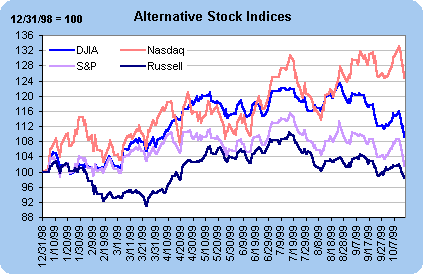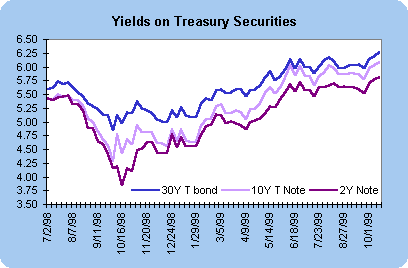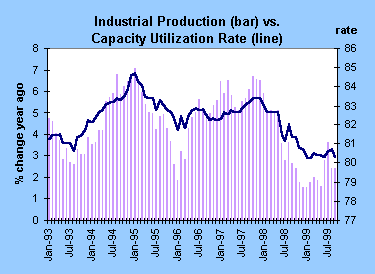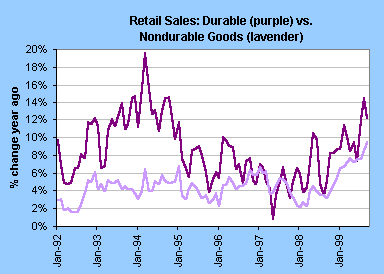
|
Today's Calendar |
| | Simply Economics |
| | International Perspective |
| | Resource Center |
 |
|
| 1999 Articles |
|
By Evelina M. Tainer Chief Economist, Econoday Inflation and Greenspan haunt financial markets
Dow momentarily dips below 10,000 
Bond yields improve on stock plunge, but still higher than last week 
PPI spurts more dramatically than expected  The attention on inflationary pressures has market participants looking at all parts of the PPI report. The PPI for intermediate goods edged up a modest 0.3 percent for the month -- and excluding food and energy was up only 0.1 percent. In contrast, the crude materials index jumped 5.1 percent in total, and the nonfood; non-energy component was up 2.2 percent. Crude materials are almost entirely affected by the energy component. On a year over year basis, crude goods prices are up 16.1 percent, although the core is only 1.2 percent higher than a year ago. As indicated in the chart below, import and export prices are continuing their upward trend. Import prices increased 0.7 percent in September after larger gains in the previous two months. Petroleum import prices jumped 7.2 percent, a moderation from the two previous months! Non-oil prices though are relatively stable -- and in fact are down 0.5 percent from a year ago.  The bottom-line on inflation? There is no question that the best inflation news is behind us. Market players and the Fed need to determine, rather, whether the modest gains of the past few months will continue, or will we see a rapid acceleration? Export prices are running on par with year ago levels. Import prices are only higher than a year ago because of the spurt in inflation. Yet, with economic growth improving in Europe and Asia, market participants and the Fed suspect that the downward pressures coming from foreign competition in the past few years won't continue. As a result, domestic producers may not have the same inclination to hold the lid on prices. The debate seemingly centers on the view that technology and productivity gains will control price increases going forward. It's true that the September PPI figures were frightening, but special factors have a way of disappearing and often reversing. While this data could force the Fed's hand into raising rates at the November 16 FOMC meeting, it doesn't necessarily set the stage for an accelerated pace of Fed tightening moves.
Industrial production still soggy  The bottom-line on production? Industrial production was weaker earlier this year and started to pick up steam just a few months ago. Several of the surveys such as the NAPM as well as factory orders have pointed to a broader recovery in domestic production. Yet, industrial production continues to run at only a moderate pace on a year over year basis. The Federal Reserve is concerned that rapid economic growth will create such tight labor markets that wage and price inflation would be a foregone conclusion. In reality, the gains in production have been anemic and factory employment has posted continuous declines.
Retail sales robust  Among durable goods, only furniture store sales rose in September. Nonetheless, increases are much higher among this group than nondurable goods stores which rose 0.8 percent for the month. About half of that rise came from higher prices at the gas pump. Sales gains were more moderate after taking the higher prices into account, but still strong enough to be a concern for Fed officials.  The bottom line on retail sales? The consumer spending spree is not over. Motor vehicle sales may have moderated in September, but consumer spending continues at a rapid clip. Fed officials are just as concerned about the rate of economic growth as the potential for inflationary pressures.
THE BOTTOM LINE Consumer spending continues to grow at a fast clip, although industrial production remains on the soggy side. In any case, September data is not as easy to interpret given that Hurricane Floyd surely affected the data. It really is too soon to determine whether the Fed will raise rates at the next FOMC meeting. This week's news makes a better case for Fed tightening. Now market players are debating not just whether the Fed will raise rates at the November meeting, but if they will raise rates early in 2000 as well. Stay tuned!
Looking Ahead: Week of October 18 to 22
Tuesday Housing starts are expected to drop 2.5 percent in September to a 1.63 million unit rate. At the same time, permits are expected to remain roughly unchanged at a 1.62 million unit rate. The weekly MBA purchase applications index has been trending lower for the past couple of months and tends to lead housing starts for three to four months.
Wednesday
Thursday Economists are predicting that the Philadelphia Fed Survey will decrease marginally in October to 15.0 after a rise in September. On the whole, this reflects solid manufacturing activity in this region. |
|||||||||||||||||||||||||||||||||||||||||||||||||||||||||||||||||||||||||||||||||||||||||||